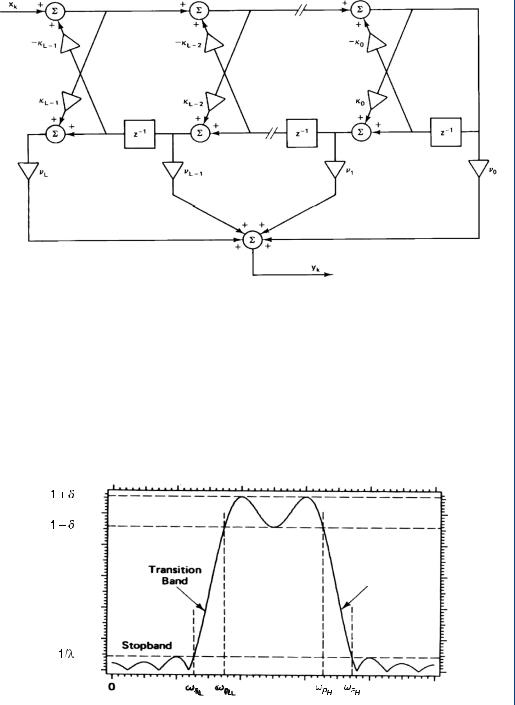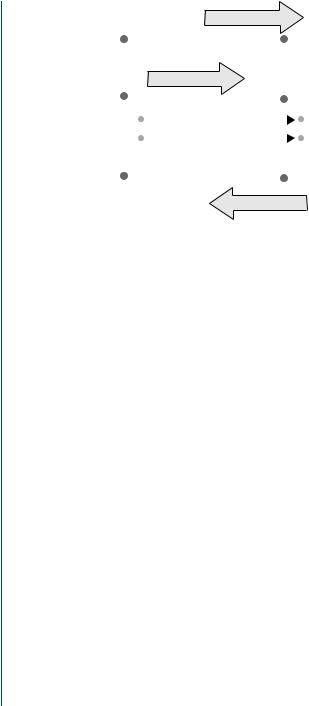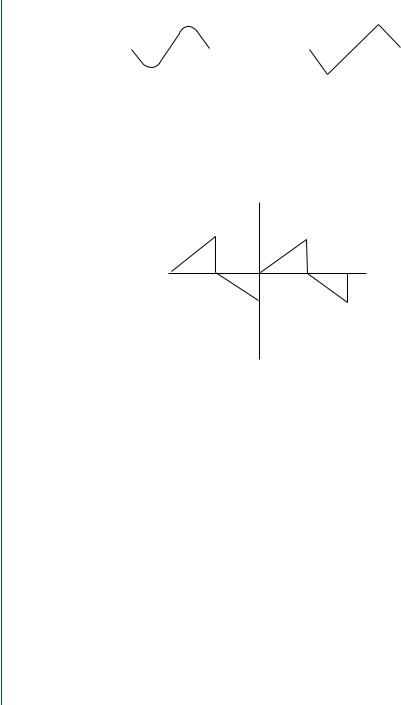
Signal Processing of Random Physiological Signals - Charles S. Lessard
.pdf
DIGITAL FILTERS 121
FIGURE 11.11: Symmetric IIR lattice digital filter
IIR filter also have a very narrow transition band, which would be desirable in band-pass and band-reject filters as shown in Figs. 11.12 and 11.13, respectively.
11.2.3Finite Impulse Response (FIR) Digital Filters
The Finite Impulse Response (FIR) filter maybe derived from the IIR transfer function equation (11.11). If the denominator terms are unity, A(z) = 1, the equation for H(z)
Magnitude
1.0
0.8 Passband
0.6 |
|
|
|
Transition |
|
||
|
|
|
band |
|
|||
|
|
|
|
|
|||
0.4 |
|
|
|
|
|
|
|
0.2 |
|
|
|
|
|
|
|
|
Stopband |
|
|
|
|||
|
|
|
|
||||
0 |
|
|
|
|
|
|
|
|
|
|
|
|
|
|
|
|
|
|
|
|
|
|
|
|
0 |
|
|
|
|
|
|
|
|
|
|
|
|
||
|
|
|
|
|
|
|
|
Transition
band
Stopband
p
FIGURE 11.12: Band-pass filter. Note the narrow transition bands in the band-pass filter

122 SIGNAL PROCESSING OF RANDOM PHYSIOLOGICAL SIGNALS
Magnitude
1.0
0.8 |
Passband |
|
Passband |
|
|
|
0.6 |
Transition bands |
|
|
0.4 |
|
0.2 |
Stopband |
|
0 |
|
|
|
|
|
0 |
|
p |
Frequency (rad)
FIGURE 11.13: Band-reject filter. Note the narrow transition bands in the band-reject filter
in the IIR direct version becomes the FIR direct-form implementation equation, as in (11.12).
H (z) = B (z) = b0 + b1−Z1 + · · · + b−LZL |
(11.12) |
The difference equation corresponding to the FIR direct-form implementation equation (11.12) is given by (11.13), and the “Direct” FIR design is shown in Fig. 11.14.
|
|
|
|
= |
L |
|
|
|
|||
|
|
|
yk |
|
bn xk − n |
(11.13) |
|||||
|
|
|
|
|
n=0 |
|
|
|
|||
|
|
Xk—1 |
|
|
Xk—2 |
|
Xk—1 |
||||
Xk |
Z |
–1 |
Z –1 |
Z –1 |
|||||||
|
|
|
|
|
|
|
|
||||
|
|
|
|
|
|
|
|
|
|
|
|
b0 |
b1 |
bL—1 |
|
bL |
+ |
+ |
+ |
|
+ |
|
+ |
+ |
+ |
yk |
FIGURE 11.14: Direct-form FIR digital filter. The numerator coefficients are the bL terms, and since the aL terms are unity there are no denominator coefficients

DIGITAL FILTERS 123
In summary, FIR filters should be used when phase is important or when flatness without ripples in the pass-band region is important in the analysis of signals. The general characteristics of the FIR filters are listed as follows:
a.many coefficients;
b.designed to have exactly linear phase characteristics; and
c.implementation via fast convolution.

125
C H A P T E R 1 2
Fourier Series:
Trigonometric
The objective of this chapter is for the reader to gain a better understanding of the Basic Fourier Trigonometric Series Transformation and waveform synthesis. If we are interested in studying time-domain responses in networks subjected to periodic inputs in terms of their frequency content, the Fourier Series can be used to represent arbitrary periodic functions as an infinite series of sinusoids of harmonically (not harmoniously) related frequencies as shown in (12.1).
A signal f (t) is periodic with period, T, if f (t) = f (t + T ) for all t, then the Fourier Trigonometric Series representation of the periodic function may be expressed as (12.1). It should be noted that both “cosine” and “sine” trigonometric terms are necessary and that an infinite number of terms may be necessary.
f (t) = a0 + a1 cos ω0t + a2 cos 2ω0t + · · · an cos nω0t + b1 sin ω0t |
(12.1) |
||
|
|
+b2 sin 2ω0t + · · · bn sin nω0t + · · · n = 1, 2, 3, . . . ∞ |
|
where ω0 = |
2nπ |
1 |
|
T |
; T = f0 ; and n is the nth harmonic of the fundamental frequency, |
||
ω0. |
|
|
|
12.1 FOURIER ANALYSIS
Recall the chapter on basis functions. In taking the integral transform of a signal, the integral of the product of the signal with any basis function transforms the work from

126 SIGNAL PROCESSING OF RANDOM PHYSIOLOGICAL SIGNALS
|
|
Forward |
|
|||
|
|
|
|
|
|
|
Time domain |
|
T |
|
|
Frequency domain |
|
Diff. equation |
|
|
|
|||
R |
|
|
|
|||
D.E. |
|
|
Complex s-plane |
|||
A |
|
|
||||
Operations: |
|
|
|
|||
N |
|
|
Operations: |
|||
Derivative |
|
|
S |
|
|
Product |
|
F |
|
|
|||
Integration |
|
|
|
|
Division |
|
|
O |
|
|
|||
|
|
|
|
|
|
|
Answer: number |
R |
|
|
results |
||
M |
|
|
||||
|
|
|
|
|
|
|
Inverse
FIGURE 12.1: Transformation from the time domain to the frequency domain
one domain, that is, time domain, into a separate domain, that is, frequency domain with either the La Place or Fourier Basis functions. The reason for working in the transformed domain is to reduce the time-domain operations of integration or differentiation to less complex operations of division or multiplication, respectively.
There are numerous forms of the Fourier Transform. The most used forms include the following:
1.The Fourier Trigonometric Series, which was used prior to the advent of computer to analyze analog data, but had the major drawback of being very time consuming.
2.The Discrete Fourier Transform was used with digitized data, and is considered to be a subset of the LaPlace Transform; however, the Discrete Fourier Transform was also very time consuming (4 minutes to analyze 1024 samples of data).
3.The Fast Fourier Transform became the most popular method used to perform transformation into the frequency domain because it was very efficient and fast.
There are many other Fourier Transforms that will not be studied in this course.
The Fourier analysis consists of two basic operations:

FOURIER SERIES: TRIGONOMETRIC 127
1.The first operation is to determine the values of the coefficients a0, a1, . . . an , and b1, . . . bn .
2.The second operation is to decide how many terms to include in a truncated series such that the partial sum will represent the function within allowable error. It is not possible to calculate an infinite number of coefficients.
12.2EVALUATION OF THE FOURIER COEFFICIENTS
In evaluating the coefficients, the limits of integration must be set. Since the Fourier Basis functions are orthogonal over the interval t0 to (t0 + T ) for any t0, we often use the value t0 = 0 or t0 =−T/2 with the understanding that any period may be used as the period of integration. Thus, we replace the interval of the integral from, t0 to (t0 + T ), with the limits of integration from, 0 to T.
The next step would be to calculate the a0 term, which is simply the average value of f (t) over a period; a0 is often referred to as the DC value of a sinusoid over N complete cycles in the period. Next the complex coefficients, an and bn , are evaluated with the expressions in (12.2), (12.3), and (12.4). To obtain the an terms, which constitute the “real-part” of the complex Fourier coefficient, the signal or function is multiplied by the corresponding cosine term, integrated, and then normalized by the fundamental period, T, as shown in (12.3). In a similar manner, to obtain the bn terms, which constitute the “imaginary-part” of the complex Fourier coefficient, the signal or function is multiplied by the corresponding sine term, integrated, and then normalized by the fundamental period, T, as shown in (12.4).
DC Value of f (t): a0 = c 0 = |
1 |
T |
T/2 |
f (t)dt = |
1 |
t0+T |
f (t)dt = |
1 |
|
|
|
|
||
−T/2 |
T |
t0 |
T |
T
f (t)dt
0
(12.2)
Real Term: an = |
2 |
T |
f (t) cos nω0t dt or |
T/2 |
(12.3) |
||
|
|
|
|||||
T |
0 |
−T/2 |
|||||
|
|
|
2 |
|
T |
|
|
Imaginary term: |
bn = |
|
f (t) sin nω0t dt |
(12.4) |
|||
|
|
||||||
T 0 |
|||||||

128SIGNAL PROCESSING OF RANDOM PHYSIOLOGICAL SIGNALS
12.3EQUIVALENT FORM OF THE FOURIER TRIGONOMETRIC SERIES
The shorthand notation for writing the Fourier series is given by (12.5).
f (t) = a0 + a1 cos ω0t + a2 cos 2ω0t + · · · an cos nω0t + · · · b1 sin ω0t
+b2 sin 2ω0t + · · · bn sin nω0t + · · · |
|
∞ |
|
f (t) = a0 + (an cos nω0t + bn sin nω0t) |
(12.5) |
n=1 |
|
However, an equivalent expression is to combine the complex coefficients, an and bn , and rewrite the coefficients in polar-coordinate terms of magnitude and phase as in (12.6).
|
|
|
|
c n cos(nω0t + θn ) = an cos nω0t + bn sin nω0t |
(12.6) |
||||
where c |
|
|
|
|
and θ |
|
tan−1 bn |
|
|
n = |
a 2 |
+ |
b 2 |
= |
|
|
|||
|
n |
n |
|
an |
|
|
|||
Then, the Fourier Trigonometric Series representation of the function may be |
|||||||||
written in the expanded form as in (12.7) or in the compressed form as in (12.8). |
|
||||||||
|
|
f (t) = c 0 + c 1 cos(ω0t + θ1) + · · · c n cos(nω0t + θn ) + · · · |
(12.7) |
||||||
where cn is the magnitude, and θn is the phase of the nth harmonic. |
|
||||||||
|
|
|
|
|
f (t) = c 0 + |
∞ |
|
||
|
|
|
|
|
c n cos(nω0t + θn ) |
(12.8) |
|||
|
|
|
|
|
|
|
|
n=1 |
|
12.4SYMMETRICAL PROPERTIES AS RELATED TO FOURIER COEFFICIENTS
12.4.1 Even Waveform Symmetries
In working with the Fourier Series, it is often advantageous to take advantages of the symmetrical properties of trigonometric functions or other wave forms. If the function f (t) satisfies the condition, f (t) = f (−t), then the function is said to be even, as shown in Figs. 12.2 and 12.3. The function will contain only the Fourier coefficients; DC, a0, and an cos nω0t terms. Note that the cosine function in Fig. 12.2 is an “even” function as is the square wave function in Fig. 12.3.

|
FOURIER SERIES: TRIGONOMETRIC 129 |
f (t) |
Cosine |
|
t |
–T/2 |
T/2 |
FIGURE 12.2: An even function. The cosine is an even function, since the function is symmet-
rical about the y -axis, that is, f (t) = f (−t)
12.4.2 ODD Waveform Symmetries
Similarly, if f (t) satisfies the condition f (t) = − f (−t), then the function is said to
be odd, as shown in Fig. 12.4. The function will contain only the Fourier coefficients bn sin nω0t terms. Note that the functions are folded symmetrically about both y- and x-axes. The negative sign before the time, t, folds the function about the y-axis whereas the negative sign before the function, f , inverts the function about the x-axis.
Another useful property to know is the “half-wave” symmetry. If the function f (t) satisfies the condition f (t) = − f (t ± T2 ), then the function is said to have half-wave symmetry, as shown in Fig. 12.5. The function will contain only the odd complex Fourier
coefficients, an and bn , for n = 1, 3, 5, 7, . . . , etc.
|
|
f (t) |
|
Square wave |
|
|
|
|
|
|
|
|
|
|
|
|
–T/2 |
|
|
T/2 |
t |
||
|
|
|
|
|
|
||
|
|
|
|
|
|
|
|
|
|
|
|
|
|
|
|
FIGURE 12.3: Another even function. The square wave function is an even function, since the
function is symmetrical about the y -axis, i.e., f (t) = f (−t)

130 SIGNAL PROCESSING OF RANDOM PHYSIOLOGICAL SIGNALS
f (t) |
Sine |
|
|
|
f (t) |
Triangle wave |
|
|
t |
|
t |
||
–T/2 |
T/2 |
|
|
–T/2 |
|
T/2 |
|
|
|
|
|
|
|
(a) Sine wave |
(b) Triangular wave |
FIGURE 12.4: Odd functions. The sine wave (a) and the triangular wave are considered to be odd functions since they satisfy the condition f (t) = − f (−t)
f (t) |
Half-wave |
|
t |
–T/2 |
T/2 |
FIGURE 12.5: Half-wave symmetric function. This triangular function is considered to have half-wave symmetry since it satisfies the condition f (t) = − f (t ± T2 )
The relationship between the properties of symmetry and the Fourier Series are
summarized in Table 12.10 and as follows:
1.Even functions contain only a0 and an cos nω0t terms.
2.Odd functions contain only bn sin nω0t terms.
3.Half-wave symmetry functions contain only the odd complex Fourier coefficients, an and bn terms, where n = 1, 3, 5, 7, . . . , etc.
Example Problem: What is the Fourier Series of the function, v(t), in Fig. 12.6? The function v(t) is given below.
V , |
0 < t < T/4 |
|
v(t) = −V , |
T/4 < t < 3/4T |
(12.9) |
V , |
3/4T < t < T |
|
